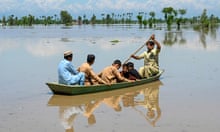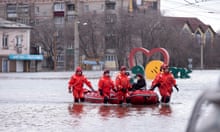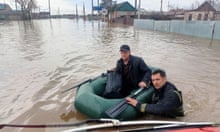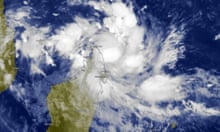Amid a historic heatwave and months of drought, Mexico’s government has launched the latest phase of a cloud seeding project it hopes will increase rainfall.
The project, which began in July, involves planes flying into clouds to release silver iodide particles which then, in theory, will attract additional water droplets and increase rain or snowfall.
Cloud seeding in Mexico is “combatting the effects of drought in rural areas and contributing to refilling aquifers”, says the agriculture ministry, which has been carrying out cloud seeding at least once a year since 2020. The government has claimed significant success, saying the project was 98% effective and even helped extinguish forest fires in 2021.
But Mexico’s leading cloud physicists have cast significant doubt on the viability of the technology and experts across fields warn against simple solutions to the effects of climate change.
“There is no evidence that cloud seeding techniques allow for the increase of precipitation over important economic zones, nor is there certainty about effects outside the targeted zone,” write Fernando García García and Guillermo Montero Martínez, cloud physicists at Mexico’s National Autonomous University (Unam).
While the Mexican government claimed cloud seeding in 2021 increased precipitation by up to 40% above forecasts, the scientists say rain forecasts are highly variable and evidence does not consistently link cloud seeding and precipitation increases. Mexican scientists oversaw the world’s longest cloud seeding study from 1948 to 1970 and still failed to produce conclusive results.
Cloud seeding, “should only be considered as one element of an integrated strategy for managing water resources”, write the cloud physicists.
The agricultural ministry did not respond to the Guardian’s questions about cloud seeding and water scarcity.

Farmers in northern Mexico, currently suffering “severe drought” as designated by Mexico’s National Water Commission (Conagua), are open to anything that could bring more rain, says Álvaro Bours Cabrera, the president of the Association of Farmers’ Organizations of Southern Sonora (AOASS).
“But we are skeptical,” says Bours. “We would prefer the government brought back investment in the irrigation distribution networks to increase efficiency and save water.”
Bours says the end of the agricultural ministry’s insurance program for farmers against extreme weather events in 2021 has left farmers at the whims of a rapidly changing climate.
Recent conditions in Mexico – as in much of the world – have put the rapidly advancing effects of climate change into focus. It was the hottest month on record in Mexico, with temperatures 2.3C higher than historical averages.
The heat killed livestock, sending dairy and beef prices up in parts of the country. It dried up firefly populations in normally humid forests, sapping tourism dollars. On the US-Mexico border in Mexicali, temperatures hit 50.2C (122F), a national record. At least 167 Mexicans have died as a direct result of the heat. It was the driest June since 1941, with rainfall 60% below averages.
“We’re used to heat like that later in the summer, not as early as June,” said Bours. “It’s very strange. Last year we had one of the coldest Junes in our region’s history. Every year we see climate change more clearly.”
In both the countryside and cities, Mexico is ill-prepared for extreme climate events, says Elda Luyando, a professor of climate change and solar radiation at Unam. Urban areas that have paved over green space are becoming heat islands. Rural areas with unsustainable agricultural practices are increasingly transforming into fallow desert.
after newsletter promotion
“We can’t be taken by surprise any more by these extreme weather events. We need to have early warnings” to plan for water, electricity and health concerns, says Luyando. “We have to be prepared because it’s going to keep happening.”
But even as the climate crisis intensifies and drought endures in northern Mexico, the most basic strategies for conserving water are overlooked, says Alfonso Cortez Lara, a professor of urban studies and the environment at the Northern Border College (Colef).
“Practically nothing has changed or rather what has changed has not had a major impact [on water sustainability],” he says.
Cortez studies Baja California state, which is reliant on the Colorado River for half its water and includes cities such as Tijuana, Mexicali and Ensenada, as well as large agricultural areas. With additional cuts to Mexico’s share of the Colorado River on the way, straightforward solutions are necessary, says Cortez.
“If we can improve efficiency in irrigation and water supply systems by 3, 4 or even 5%, we could recover tremendous amounts of water,” he says.
In addition to making irrigation systems more efficient, Cortez suggests the lowest-hanging fruit for water scarcity is to improve water infrastructure in cities to reduce loss and better regulate wells to prevent aquifers from drying up.
Instead, Cortez says these basic improvements are often overlooked in favor of moonshot projects like cloud seeding and desalination plants.
The state government is investing millions in upcoming public-private desalination plants.
“Desalination plants are the most costly alternative, they’re polluting, they’re energy-intensive,” says Cortez. “As an alternative, it could be on the list but it should not be at the top of the list.”









